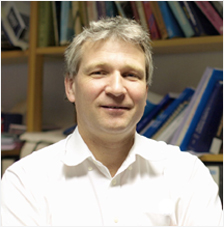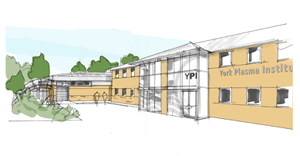York's boost to plasma science research

The establishment of the York Plasma Institute on the Science Park is set to create opportunities for major advances in hot and cold plasma science in collaboration with industry here at the University of York.
High-temperature plasmas
The main current focus of research is fusion energy: the production of 'clean' energy using the nuclear fusion processes which power the Sun. This is conducted in either tokamaks through magnetic confinement fusion, where the hot plasma is controlled using magnetic fields, or inertial confinement fusion in which high-power lasers are used to produce the hot plasma.
Low-temperature plasmas
Current industrial uses include the application of optical, reflective and protective coatings; manufacture of chips in computers and mobile phones; manufacture of solar cells. Biomedical applications include sterilisation (plasmas can effectively kill bacteria), and control of blood coagulation during surgery (plasma intervention is preferred because it is non-contact so 'cleaner', causing less inflammation).
Construction work started at the beginning of the year, and the next few weeks will see the completion of the main building of the York Plasma Institute. New laboratory facilities will be housed in an adjacent experimental hall later this year. This will host existing, high-temperature experimental plasma research and the new low-temperature plasma laboratory.
Plasma is a substance having properties different from those of solids, liquids, and gases, and is considered to be a distinct state of matter. It is essentially an ionised gas. It can be produced by heating a gas until the electrons in the atoms break free of the nucleus, creating a sea of charged particles: negatively charged electrons and positive nuclei.
Most material in the universe exists in the plasma state, although it is less common here on Earth. For example, the Sun is a plasma, and the beautiful Northern Lights is a particularly striking example of a plasma interacting with a magnetic field (in this case, the Earth’s).
The Sun is powered by fusion energy. If this can be reproduced here on Earth, it would provide an effectively limitless supply of safe, relatively clean energy. Fusion energy research looks at plasma in its hot state, seeking to recreate the high temperature conditions similar to those in the core of the Sun. York is already a collaborator with the national fusion programmes at Culham Centre for Fusion Energy (CCFE) and the Rutherford Appleton Laboratory, both near Oxford, as well as other international fusion laboratories.
The new Institute, a partnership with the Engineering and Physical Sciences Research Council (EPSRC), will bring together existing research into high-temperature plasmas with research into the properties and applications of low-temperature plasmas. Cold, or “non-thermal”, plasmas are already widely applied in industry, in uses ranging from TV sets and lighting, through tungsten carbide coatings on drill bits (for example), to the manufacture of computer chips and textiles.
But it is the exciting potential of plasmas in biomedical applications which is one of the most rapidly expanding fields of research. Already in use to create biocompatible surfaces for prosthetics, and for the sterilisation of equipment, low-temperature plasmas are now the focus of new surgical innovations with their potential for “non-contact” controlled applications to living tissue.
 The Institute’s Director, Professor Howard Wilson, explained
the benefits of having these two areas of research under one roof: “The York
Plasma Institute will provide a unique research and education facility in the UK. By bringing different areas of plasma science
together we’ll be better placed to exploit synergies between the fields and
related disciplines, and drive collaborations with industry.”
The Institute’s Director, Professor Howard Wilson, explained
the benefits of having these two areas of research under one roof: “The York
Plasma Institute will provide a unique research and education facility in the UK. By bringing different areas of plasma science
together we’ll be better placed to exploit synergies between the fields and
related disciplines, and drive collaborations with industry.”
A new team of world-class academics will be recruited to lead the new research group focusing on the science and technology of low-temperature plasmas who, with the support of a dedicated Industry Officer, will work closely with industry and collaborators from other universities to refine existing technological applications and develop new ones.
By bringing different areas of plasma science together we’ll be better placed to exploit synergies between the fields and related disciplines, and drive collaborations with industry
Professor Howard Wilson
The Industry Officer will also work in partnership with CCFE (which is part-funding the position) to develop links between UK industry and the international fusion energy programme, in particular the €10bn ITER fusion energy facility under construction in France. ITER is a collaborative project between China, the EU, India, Japan, Korea, Russia and the USA, designed to answer the question of whether or not a fusion power plant is possible. The scientific research carried out by the York plasma group plays an influential role in the international science programme for ITER.
In preparation for ITER, the York group's fusion research focuses on developing an understanding of the plasma physics processes in a tokamak (a type of fusion reactor, such as the ITER device, within which hot plasma is confined for energy production). Plasma in a tokamak is hotter than the core of the Sun, at over 100 million degrees Celsius. Those plasmas are beginning to approach the conditions for fusion to occur, but are limited by instabilities and turbulence. Resolving these problems, as well as how the hot plasma interacts with materials, is key to the viability of fusion energy as the reliable, environmentally friendly global energy source scientists believe it can become.
The York group is also involved in an alternative approach to fusion energy called inertial fusion. High power lasers are used to compress small pellets of fusion fuel. Compressing these pellets to one thousandth of their normal volume can provide extremely dense, hot plasmas to create a burst of fusion energy. Repeating this process many times per second could provide the energy for a fusion power station. The York group performs experiments at the Central Laser Facility at the Rutherford Laboratory, as well as other facilities around the world. The National Ignition Facility in the US is expected to produce the first fusion energy burst using this technique in the next year or so.
 The new Plasma Institute will enable York scientists from the fields of physics,
biology and chemistry to develop and expand cutting-edge research in all areas
of plasma science. The Vice-Chancellor,
Professor Brian Cantor, said "The York Plasma Institute provides an
exciting environment to foster interdisciplinary development of plasma science
and technology. It will nurture collaborative programmes between University
academics and industry to maximise the value of our research and its impact on
society."
The new Plasma Institute will enable York scientists from the fields of physics,
biology and chemistry to develop and expand cutting-edge research in all areas
of plasma science. The Vice-Chancellor,
Professor Brian Cantor, said "The York Plasma Institute provides an
exciting environment to foster interdisciplinary development of plasma science
and technology. It will nurture collaborative programmes between University
academics and industry to maximise the value of our research and its impact on
society."
Dr Andrew Bourne, Head of EPSRC's Physical Sciences Programme said: "EPSRC is delighted to sponsor this new centre that aims to innovatively integrate research activities from various plasma research approaches from both the major UK research laboratories and international collaborations. The strategic focus is centred on establishing new cooperation in the emerging technological plasma research area with industry as well facilitating the access of small/medium scale enterprises in the UK to the EU and international fusion research programmes. This has the potential to be of great benefit to the UK."
Further information
